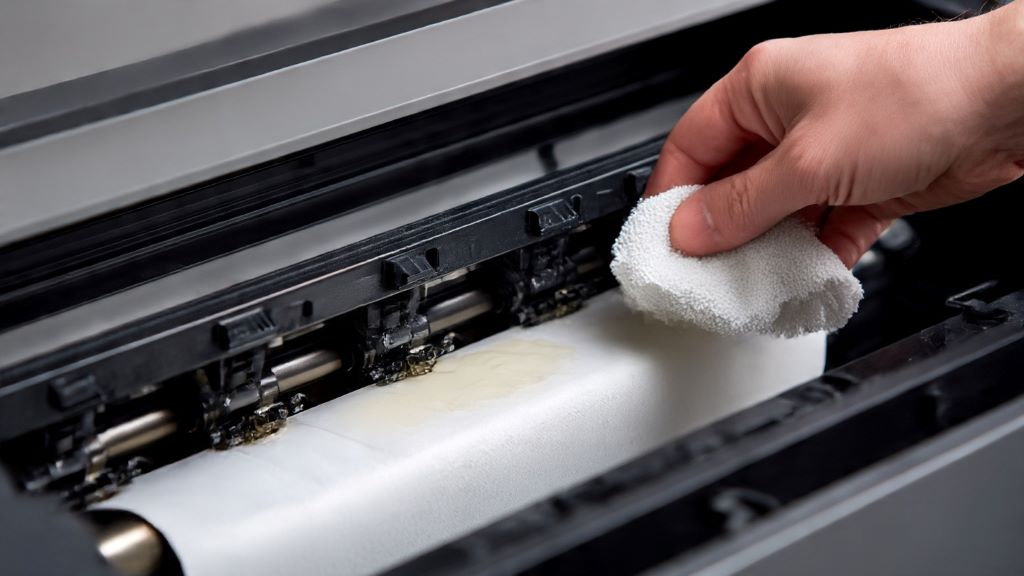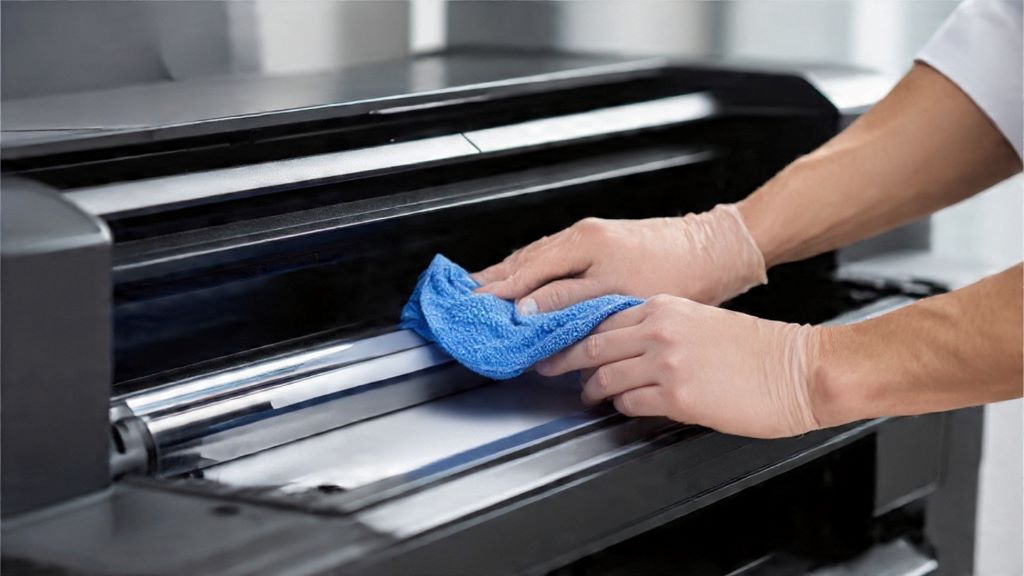Paper slipping during intake is one of the most frustrating printer problems you’ll encounter. When sheets refuse to feed properly or multiple pages grab at once, your productivity grinds to a halt. Fortunately, this common issue usually stems from dirty or worn rollers that need attention. The experts at Mech Office understand how critical smooth paper feeding is for both home and business printing needs. This guide will walk you through identifying why your printer struggles with paper intake and provide practical solutions to restore reliable feeding.
Understanding Why Printer Paper Slips
Before diving into solutions, it’s helpful to understand what causes paper slipping. Your printer uses rubber rollers to grip and pull paper through the machine. Over time, these rollers accumulate dust, paper fibers, ink residue, and oils from handling. This buildup creates a slippery surface that cannot grip paper effectively. Additionally, rubber naturally degrades with age and use, becoming hard and smooth rather than tacky and grippy.
Environmental factors also play a role. Humidity affects paper texture, making it either too limp or too stiff. Temperature changes can cause paper to curl slightly, preventing proper contact with rollers. However, the most common culprit remains dirty rollers that have lost their ability to grab paper securely.
How Cleaning Rollers Solves Paper Slipping
The primary solution to paper slipping involves restoring the rollers’ grip. Learning how to clean printer rollers is essential for maintaining your printer’s performance. Clean rollers regain their tackiness and can properly grip each sheet as it enters the printer. This simple maintenance task takes only minutes but dramatically improves feeding reliability.
Regular cleaning prevents the gradual buildup that leads to slipping. Think of it like cleaning your car’s windshield. A little dirt seems manageable until suddenly you realize you can barely see through it. Similarly, roller contamination happens gradually until your printer refuses to feed paper altogether.
Step-by-Step Guide to Fixing Paper Slipping
Start by turning off your printer and unplugging it from the power source. Safety should always come first when working with electronic devices. Open the paper tray completely and remove all paper. This gives you clear access to the feed rollers.
Locate the pickup rollers near the paper tray. These are usually gray or black rubber cylinders visible when you look into the paper path. You’ll typically find one or two primary feed rollers plus several smaller guide rollers throughout the paper path.
Dampen a lint-free cloth with distilled water or isopropyl alcohol. Avoid using tap water, as minerals can leave residue. Gently wipe each roller, rotating it manually to clean the entire surface. You’ll likely see dirt transferring onto your cloth. Continue wiping until the cloth comes away clean.
For stubborn buildup, slightly more pressure may be necessary. However, avoid using excessive force that could damage the rubber. Some technicians recommend using a specialized rubber rejuvenator solution for severely degraded rollers, though replacement might be more cost-effective for very old printers.
After cleaning, allow rollers to dry completely before reassembling. This typically takes just a few minutes. Once dry, reload your paper and run a test print. Most users notice immediate improvement in paper feeding.
Preventive Maintenance Tips
Regular maintenance prevents paper slipping from recurring. Clean your rollers every three to six months, depending on printing volume. High-volume users should clean monthly, while occasional home users can extend this timeline.
Store paper properly in a cool, dry place. Keep it in its original wrapper until needed to prevent moisture absorption or dust accumulation. Paper quality matters significantly. Cheap paper often sheds more fibers, accelerating roller contamination. Investing in quality paper actually reduces maintenance needs.
Additionally, avoid overloading paper trays. Most trays have maximum capacity indicators. Exceeding these limits puts excessive pressure on feed mechanisms and increases the likelihood of multiple sheets feeding simultaneously.
When to Replace Rather Than Clean
Sometimes cleaning isn’t enough. Inspect your rollers carefully during cleaning. If the rubber appears cracked, excessively smooth, or has visible damage, replacement is necessary. According to HP’s printer maintenance guidelines, rollers typically last 50,000 to 100,000 pages depending on the model and usage patterns.
Hardened rollers that have lost their elasticity won’t regain it through cleaning. You can test this by pressing gently on the roller surface. It should feel slightly soft and grippy, not hard and slick. Replacement roller kits are available for most printer models and often cost less than a single service call.
Therefore, weigh the cost of replacement parts against your printer’s overall value. For older, inexpensive models, investing in new rollers might not make economic sense compared to replacing the entire unit.

Troubleshooting Persistent Slipping Issues
If cleaning doesn’t resolve your paper slipping, investigate other potential causes. Check that you’re using the correct paper type setting in your printer preferences. Mismatch between actual paper and printer settings can cause feeding problems even with clean rollers.
Examine your paper for damage or irregularities. Torn edges, bent corners, or moisture damage all interfere with proper feeding. Try a fresh ream of paper from a different package to rule out paper-related issues.
Furthermore, inspect the paper tray itself for damage or misalignment. Worn guides that don’t properly position paper can cause skewed feeding. Ensure the paper rests flat against the tray guides with no gaps or wobbling.
Separation pads, which work alongside rollers to ensure only one sheet feeds at a time, also wear out. These cork or rubber pads might need replacement if you consistently experience multiple sheets feeding together despite clean rollers.
Understanding Roller Types and Functions
Modern printers use several roller types, each serving specific functions. Pickup rollers initiate paper movement from the tray. These experience the most wear since they perform the initial grab. Transfer rollers move paper through the printing mechanism. Exit rollers push completed prints into the output tray.
Different roller types may require different cleaning frequencies. Pickup rollers need the most frequent attention, while exit rollers typically stay cleaner since they only contact printed paper. Nevertheless, clean all accessible rollers during maintenance sessions for best results.
Some advanced printers feature automatic cleaning cycles that users can initiate through the control panel. While helpful, these don’t replace manual cleaning but rather supplement it by removing loose debris.
Professional Help and Resources
Sometimes professional servicing is warranted. Persistent paper feeding issues after thorough cleaning might indicate mechanical problems beyond simple maintenance. Worn gears, misaligned sensors, or failing motors require technician expertise.
Many printer manufacturers offer diagnostic tools that identify specific problems. Running these utilities before calling for service helps technicians prepare appropriate solutions. Contact manufacturer support for guidance on accessing built-in diagnostics.
Extended warranties or service plans often cover roller replacement and related maintenance. Review your printer’s warranty terms to understand what’s included. Business-grade printers typically include more comprehensive service options than consumer models.
Conclusion
Fixing printer paper slipping on intake primarily involves cleaning the rollers that grip and feed paper through your machine. This simple maintenance task restores proper friction and eliminates most feeding problems. Regular cleaning every few months prevents buildup and extends roller life. However, severely worn or damaged rollers require replacement rather than cleaning. By understanding your printer’s paper path, maintaining clean rollers, using quality paper, and knowing when professional help is needed, you can ensure reliable paper feeding for years to come. Don’t let paper slipping disrupt your workflow when solutions are this straightforward and accessible.
Frequently Asked Questions
How often should I clean my printer rollers?
Clean your printer rollers every three to six months for typical home use. However, if you print frequently or work in a dusty environment, monthly cleaning is advisable. High-volume office printers benefit from monthly maintenance to prevent paper feeding issues before they disrupt workflow.
Can I use water to clean printer rollers?
Yes, distilled water works well for cleaning printer rollers. Use a lint-free cloth dampened with distilled water, not tap water which contains minerals. Isopropyl alcohol is also effective and dries faster. Avoid harsh chemicals, household cleaners, or abrasive materials that could damage the rubber.
Why does my printer grab multiple sheets at once?
Multiple sheets feeding simultaneously typically indicates either dirty rollers or worn separation pads. Clean all rollers thoroughly first. If the problem persists, the separation pad likely needs replacement. This cork or rubber component prevents multiple sheets from feeding together and wears out over time.
How do I know if rollers need replacement instead of cleaning?
Inspect rollers for cracks, excessive smoothness, or hardening. Press gently on the rubber surface. It should feel slightly soft and tacky. If rollers are hard, slick, or visibly damaged, replacement is necessary. Cleaning cannot restore elasticity to degraded rubber that has aged beyond its useful life.
Does paper quality affect roller performance?
Absolutely. Low-quality paper sheds more fibers and dust, accelerating roller contamination. It may also have inconsistent thickness or texture that interferes with feeding. Investing in quality paper designed for your printer type reduces maintenance needs and improves overall print reliability and quality.
Related Topics:
What to Do If Tree Roots Enter a Drain


